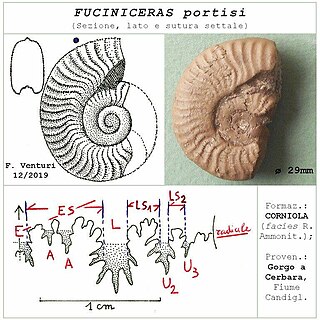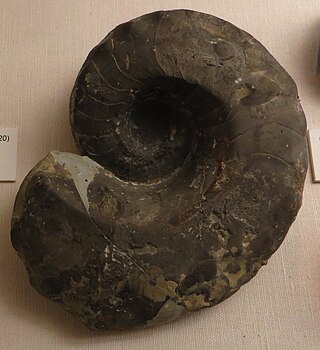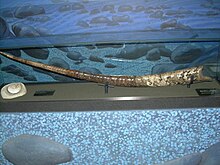
The Nautilida constitute a large and diverse order of generally coiled nautiloid cephalopods that began in the mid Paleozoic and continues to the present with a single family, the Nautilidae which includes two genera, Nautilus and Allonautilus, with six species. All told, between 22 and 34 families and 165 to 184 genera have been recognised, making this the largest order of the subclass Nautiloidea.
Aulacosphinctes is an extinct genus of ammonoid cephalopod that lived during the Late Jurassic and had a widespread distribution.

Aspidoceras is an extinct ammonoid cephalopod genus belonging to the family Aspidoceratidae.

Fuciniceras is an extinct cephalopod genus included in the ammonoid family Hildoceratidae,, that lived during the Pliensbachian stage of the Early Jurassic. The shell of Fuciniceras is generally small, evlute, and strongly ribbed.
Paraceltitidae is a family of Middle and Upper Permian cephalopods, that comprise the earliest of the Ceratitida. Paraceltitidids have variably ribbed, discoidally evolute shells with compressed elliptical whorl sections and simple suture lines. Their origin is most likely in the Daraelitidae of the Prolecanitida and they are the apparent source of the Xenodiscidae. All together they lived for some 12 million years, from about 270.6 to about 258 million years ago.

Parapuzosia is an extinct genus of desmoceratid ammonites from the Cenomanian to the Campanian of Africa, Europe, and North America. They are typically very large ammonites, reaching diameters of 60 cm (2.0 ft) or more, with the largest species measuring around 2 m (6.6 ft). It possesses a moderately involute shell with flat or slightly rounded sides. Distinct primary and secondary ribbing can be observed in the inner whorls.
Metrolytoceras is an extinct cephalopod genus that lived during the Middle Jurassic, characterized by a planispiral evolute shell with smooth middle and outer whorls, flat sides and simplified sutures.
Megasphaeroceras is an ammonite genus included in Sphaeroceratidae, a family of ammonoid cephalopods characterized by their spheroidal shells with markedly eccentric coiling, fine ribbing, and complex sutures, known from the Bajocian.
Labyrinthoceras is an extinct cephalopod genus included in the ammonoid family Sphaeroceratidae, a member of the superfamily Stephanoceratoidea, that lived during middle of the Jurassic Period.
Hebetoxyites is a genus of ammonoid cephalopod from the middle part of the Bajocian stage, middle Jurassic, included in the Strigoceratidae, Haploceratoidea. The shell is oxyconic, with a sharp rim but no keel, and involute, with the inner whorls hidden. The umbilicus is very small. Sides have a spiral ridge but are not striate.

Medlicottiidae is a family of ammonoid cephalopods belonging to the Prolecanitida, known from the Upper Carboniferous (Pennsylvanian) to the Early Triassic.
Mericoceras is an extinct nautiloid cephalopod that lived during the Late Devonian and possible as early as the Silurian.

Gymnites is a genus of ammonoid cephalopod from the Middle Triassic belonging to the ceratitid family Gymnitidae. These nektonic carnivores lived during the Triassic period, the Anisian age.

Tornoceras is a strongly involute, subdiscoidal Middle and Upper Devonian goniatite with a suture that forms six to ten lobes. Tornoceras is an extinct genus of cephalopods that shares similarities with the modern pearly nautilus. This genus first appeared during the Devonian Period, which spanned from 416 million to 359 million years ago. The shell is circular and relatively flat, with the final whorl enveloping the previous ones. The sutures between the successive chambers of the shell exhibit a gently rippled pattern.

Eutrephoceras is an extinct genus of nautilus from the Late Jurassic to the Miocene. They are characterized by a highly rounded involute shell with slightly sinuous suture patterns.

Germanonautilus is a cephalopod genus included in the nautilid family Tainoceratidae, found widespread in the Triassic of North America, Europe, Asia, and north Africa. The shell is a moderately involute nautilicone ; whorl section subquadrate to trapezoidal, widest across the umbilical shoulders, flanks flattened and ventrally convergent, venter flat and wide, dorsum narrowly and deeply impressed. The suture is with broad and deep lateral lobes and a shallow ventral lobe. The siphuncle is central and nummuloidal, composed of expanded segments that give a beaded appearance.

Lytoceras is an ammonite genus that was extant during most of the Jurassic and Cretaceous periods, and is the type genus for the family Lytoceratidae. These cephalopods were fast-moving nektonic carnivores.
Olenekoceras is an ammonoid cephalopod from the Lower Triassic included in the ceratitid family Sibiritidae, once included in the Noritaceae but now in the Ceratitaceae.

Virgatites is an extinct genus of ammonoid cephalopod belonging to the family Perisphinctidae. Related genera in the Virgatitinae include Acuticostites and Zaraiskites. Species in this genus were fast-moving nektonic carnivores.

The Acanthoceratinae comprise a subfamily of ammonoid cephalopods that lived during the Late Cretaceous from the latter early Cenomanian to the late Turonian












